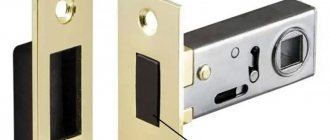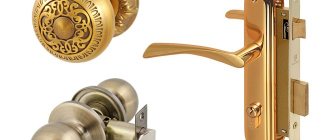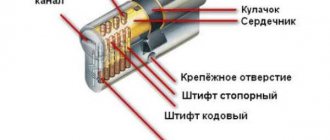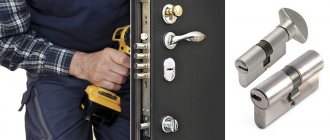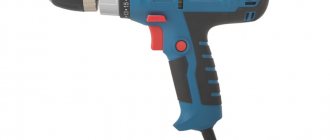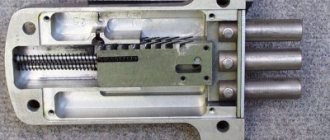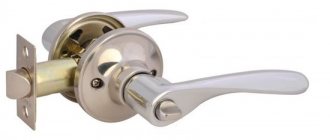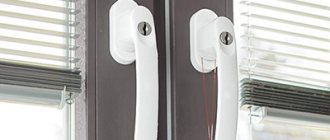Where can an electromagnetic lock be installed?
The main feature of electromagnetic locks is their versatility. They are used on almost all types of structures - on entrance and interior doors, on wickets and swing gates.
When choosing a place for installation, you should take into account the relevance and operating features of the product.
So, installing an electromagnetic lock on the door in a toilet or bathroom does not make sense - it is expensive. In addition, when installing the lock outdoors, it is worth providing protection against moisture getting into the mechanism.
Application of EMZ in a single circuit with an intercom
An electromagnetic lock for a gate, where the set does not include an intercom, can work with this device in a single circuit, which you can assemble yourself. The calling panel is mounted on the street side of the entrance doors. The connection diagram for an intercom with an electromagnetic lock involves receiving power and transmitting a video/audio signal via the same combined cable.
The video intercom monitor is installed indoors, and its power is supplied from a 220 V network. A mortise or overhead electromagnetic lock is mounted on a gate made of either wood or metal. Its power is provided by controlled contacts, which are located on the calling panel. The EMZ’s own power supply is located indoors and takes energy from a household electrical network with a voltage of 220 V. A cable with a cross-section of half a square is drawn from it to the EMZ, if the distance does not exceed a couple of tens of meters, or one and a half squares, if it is greater.
Connection diagram for a video intercom with an electromagnetic lock:
Design and principle of operation
The undeniable advantage of an electromagnetic lock is its simplicity of design. The product is based on a core with a winding, hidden in a special housing.
The core deserves special attention. It consists of many sheets of electrical steel, characterized by a slight magnetizing effect. To reduce residual stress, a paint coating is used.
The core, formed from plates, most often has an W-shape. The winding is a coil with a copper wire wound on it. The conductor is coated on top with a special insulating compound.
The product body is made of aluminum or steel. Sometimes plastic is also used, but its disadvantage is a lower resource and less reliable design.
The operating principle is based on the action of electricity and magnet. It is triggered after voltage is applied to the winding and the magnetic elements are activated. As a rule, 5 W of power is enough to securely fix massive doors weighing up to 150 kg.
When the EMC is turned on and off, an electromagnetic circuit is formed, which is affected by alternating current. With the help of a capacitor, charging is carried out through the winding, due to which the polarity of the magnet changes. In this case, the residual current is directed to magnetization reversal.
One of the main elements of an electromagnetic lock is a capacitor. If it breaks, it may be difficult to open the doors.
The solution in this case is only to replace the faulty element and connect it parallel to the terminals.
How to choose a lock
Before purchasing, it is important to pay attention to the following points:
- Pull-off (holding) strength. Should be in the range of 150‒200 kg. Indicated on locks after the index “ML”.
- Structural strength. Products with a cast anti-corrosion body are more reliable. There are no seams or joints on the surface.
- Resistant to moisture and temperature changes. The lock will be used outdoors, so the operating temperature range should be from -30 to +50 degrees. The mechanism is protected from moisture.
- High degree of anti-corrosion coating. The better the product is processed, the longer it will last and the less it will wear out.
- Complete insulation of electrical wires and other parts. Otherwise, there is a risk of electric shock when opening.
- Possibility of modification. The model must be compatible with video surveillance systems, intercom, and remote control.
- The protective coating is selected based on the frequency of use and weather conditions. For intensive use in harsh winter conditions, it is better not to save money and buy one coated with a metal film. With moderate use, an inexpensive varnish or silicone coating is sufficient.
Regardless of the model, gate locks should be equipped with anti-vandal protection on a magnet so that strangers cannot damage the mechanism.
Advantages and disadvantages of the device
Like any other locking mechanisms, electromagnetic locks have their pros and cons.
Advantages:
- Quiet operation;
- Long service life;
- Possibility of combination with an intercom, call button, code entry panel and other mechanisms;
- Modern appearance.
Flaws:
- Large dimensions and weight;
- High voltage requirements;
- Ease of re-entry (after a successful first hack).
An electromagnetic lock is directly dependent on electricity. Without power supply, it stops performing its assigned tasks. This feature can be counted among the advantages and disadvantages of the devices.
From a fire safety perspective, this is a plus, because when the power is turned off, the doors in complexes with large crowds of people must open.
Based on security conditions, turning off the electromagnetic locking device when there is a loss of voltage is a minus, because it simplifies the task for an attacker planning to break into an apartment or house.
That is why UPSs (uninterruptible power supplies) are often used when installing such devices.
Algorithm for connecting locks to various types of door leaves
- Dependence on the power grid. Not all models are equipped with batteries, so if there is a power outage, the doors will open automatically.
- Price. The price for an electromagnetic lock is slightly higher than for a mechanical one.
- Appearance. Most users find the device less attractive than a standard lock.
Useful tips Connection diagrams Principles of operation of devices Main concepts Meters from Energomer Precautions Incandescent lamps Video instructions for the master Testing with a multimeter
Main technical parameters
An electromagnetic lock has a number of characteristics that should be taken into account when selecting and purchasing a device.
Among them:
- Holding strength. Typically, electromagnetic locking products have a high pull-out load (measured in kilograms). On sale you can find products that have a holding force of 100 to 1000 kilograms or more. When choosing a product from one manufacturer, keep in mind that the step between different models is from 50 to 100 kilograms. For interior doors, a holding force of 150 kg is sufficient, and for entrance doors, this parameter should be 250 or more. For metal, the requirements are even higher - from 1000 kg.
- Residual magnetization. During operation, there are situations when a door with an electromagnetic lock opens with great difficulty. This is due to the presence of residual magnetization of EMC caused by errors in the technological process or incorrect choice of magnet parameters. The optimal residual magnetization should be no more than 1.5 - 2 kg.
Magnetic lock for interior doors
“Any electromechanical equipment will be affected by the condition of the door,” says Hatzinger. Does the door work? This may be more difficult to do when the equipment operation is less than ideal. Often you will find that the building materials will dictate; for example, a metal frame with a solid concrete filled cement frame may have hollow metal doors so you can run wire to an electrified lever kit against trying to cut out the shock. In most cases the solution will be obvious.
Types and types of electromagnetic locks and features of their installation
All electromagnetic locks are divided into two types:
- By closing method;
- According to management features.
There are also a number of subspecies that differ in the principles of locking:
- Retaining. In such EMZ, the armature of the device works by separation. The most popular here are rim locks, but there are also mortise locks (used less frequently due to low adhesive force);
- Sliding. In such an electromagnetic lock, the operating principle is based on the shift of the armature. Sliding electromagnetic locking devices are usually mortise-mounted, and their installation requires special attention and strict adherence to instructions.
Features of service and product care
It boils down to the following tips:
- Follow safety precautions carefully. It is important not to mix up the input and output terminals. Do not leave parts of the lock exposed, otherwise there is an increased risk of a short circuit.
- Monitor the condition and wear of the plates. Tight adhesion to the electromagnet depends on this. When moisture gets in, the surface begins to oxidize and the adhesion force decreases.
- Use self-tapping screws carefully when installing so as not to damage the elements. Fasten the plate securely.
The lock does not need lubrication. It is important to follow the installation and operating instructions.
A fence gate lock powered by an electromagnet is an excellent option for an affordable closing device in the presence of constant voltage.
Electromagnetic locks with controller
EMZ with an autonomous controller are becoming increasingly popular. The devices are installed in apartment buildings, on the entrance doors of industrial facilities and administrative institutions.
EMZ with control can be used in conjunction with the following devices:
- Sensors signaling the opening of the door;
- Key readers (there are contact and contactless);
- Lock opening buttons (have a normally open contact);
- External buzzers and LEDs;
- Input inversion jumper, with which you can unlock the doors by supplying or removing power.
The advantage of an EMZ with a controller is that it is compatible with the computer where the key database is stored. You can also quickly download and upload the mentioned information using a PC.
What is included in the electromagnetic lock kit?
To install the device, you will need not only a lock, but also a number of additional mechanisms.
An electromagnetic lock kit is a set of elements that are installed in various rooms and meet the stated requirements.
The electromagnetic lock kit consists of the following elements:
- Lock. Sold with wires for connecting to a voltage source and a counter plate;
- Controller is a device used to control the lock. Using the controller, the main elements of the electromagnetic protection device are connected;
- Data reader (used for opening). The mechanism can be unlocked by entering a code or using an electronic key. The latter may take the form of a card or key fob. Taking into account the model, a suitable code panel is selected;
- Keys. Typically, six keys come with an electromagnetic lock. One of them is already programmed for a certain opening frequency. Using the master key you can recode the others;
- Login buttons. These elements are installed indoors and are necessary to facilitate exit from the building without the use of keys;
- Power unit. The purpose of the device is to power the EMZ. The power supply is connected to a household voltage of 220 V. In addition, for uninterrupted supply of current to the electronic lock, the power supply unit is equipped with batteries. An auxiliary power supply allows you to avoid EMC failure in the event of loss of voltage necessary to hold the lock in the closed position (not always installed);
- Electrical wires - used to assemble a circuit.
It is worth noting that on sale you can find not only ready-made kits, but also individual models of locks.
Here are some options:
- ML400 is an electromagnetic lock that is suitable for installation on entrance doors with a thickness of 30-50 mm. The product is installed from the inside, and the canvas opens outward. A closer is used for reliable fixation. The holding force of the mechanism is 400 kg, and the supply voltage is 9-12 V. Power consumption is 7.2 W. The lock opens when the current is removed.
- AL-400S is a universal sliding-type EMZ with a holding force of 400 kg. Supply voltage - 12 or 24 Volts. Current consumption is 0.9 Ampere. The equipment is mounted inside the canvas, equipped with a reed switch and a sensor that monitors the blocking. It is also possible to display information on the security console.
- YLI YM-60 is a surface-type electromagnetic lock with a holding force of 60 kg. The device has a low holding force, so it is mounted on cabinets. The product is made of anodized aluminum and has a supply voltage of 12 Volts. The counter part is made of zinc. The package includes a mount, a mating part, EMZ, and instructions.
- Visit ML300 (M)-40 is an electromagnetic lock designed for video intercoms, intercoms and access control systems. The locking mechanism opens when the voltage is removed. The kit includes a housing with an electromagnet and a metal counterplate. The supply voltage ranges from 9 to 15 Volts, and the power consumption is up to 7.2 W.
- Arny Mag 180 is a classic EMZ with a holding force of 180 kg. The device is completely sealed, is powered by a voltage of 12 V and consumes a current of 300 mA. It is compact and reliable.
Installation procedure
The peculiarity of the operation of EMZ of various modifications - the control principle (electronic, push-button), the presence/absence and specifics of connecting sensors - does not relate to the issue of installing products on the door; this is a separate topic.
Installation is carried out strictly according to the manufacturer's instructions. Depending on the modification of the sample, there are separate nuances when attaching and connecting each one. But the general algorithm of actions is as follows.
Installing a rim lock
Marking. The manufacturer includes a stencil for each electromagnetic lock. For overhead-type models, the mounting location is selected in the upper part of the canvas, closer to the vestibule. This is the name of the vertical post of the box (jamb), on which the strike plate for traditional “tongue” locks (latches, latches) is attached. To understand the feasibility of this decision, it is enough to remember the “rule of leverage”.
The stencil is applied to the jamb, and when the door is closed, the position of the lock is determined. With the expectation that the fixed “reciprocal” plate simultaneously completely coincides with the magnet and does not interfere with the free movement of the blade. Points for installation of fasteners are outlined.
Drilling:
- Under the lock - according to the location of the holes on its body.
- There is a through one under the plate, and one more for the fixing pin. It prevents it from rotating around the axis of the fastener.
Installation of EMC and plate. The necessary fasteners are supplied with the product. Before fixing the magnetic plate, a special insert (rubber rubber or thick film) is placed under it. Installation without this element is fraught with rapid damage to the lock. The “lining” provides cushioning for the plate, and therefore there is no risk of damage to the magnet due to temperature deformations of the steel sheet.
Installing a sliding lock
The optimal location is in the middle part of the canvas (along the height) or at the top, at the edge. The operations performed are almost identical.
Note. If an electromagnetic lock is installed on a plastic or glass door, then, taking into account the narrow frame and small width of the box, corners are used to secure its components.
Connection
The specifics of operation depend on the circuit of the magnetic system. But a number of tips will not be superfluous.
- All wiring is carried out only in a hidden way. You need to understand that the main thing here is not the aesthetic side of the issue, but safety. Cables (wires) that are easily accessible can be cut off (thereby demagnetizing the lock) in a couple of minutes.
- Wires are only in PVC braid, cross-section - not less than 0.5.
- An interesting question is their number. It is easy to determine from the diagram. But the maintainability of the system must also be taken into account. Since the route will be hidden (under plaster, panels, wallpaper), it is advisable to lay an additional “line”, that is, + 1 wire.
Everything is quite simple, especially since an installation manual is included with the product. It only remains to add that electromagnetic locks of the overhead type in some cases should be duplicated with conventional “reed” mechanisms. Otherwise, when the power supply/voltage is turned off, the passage will be open.
Additional devices for connecting to EMS
During the installation process, additional devices can be connected to the electromagnetic lock to increase its functionality and reliability.
Here are some of them:
- Intercom;
- Video intercom;
- Door closer;
- Call button;
- Code entry panel and other products.
The closer ensures smooth closing of a heavy door leaf, which reduces the wear rate of parts and helps extend service life.
If the EMZ is installed on a gate or gate, an intercom is installed along with the device.
EMZ on a metal entrance door
The parameters of the electromagnetic lock (power in kilograms) directly depend on the weight of the doors
Without exception, all such devices, regardless of where they will be installed, have a common operating principle and design. The only difference between electromagnetic locks for metal doors is their greater power. Considering the strength of the door leaf, it makes sense to use in this case models that have a door holding force of 500 kg or more.
However, in modified situations, it is more dangerous for installers because drilling into the door can destroy the door—and their profits. Electric lock manufacturers have made a concerted effort over the past few years to make it easier for integrators. In addition to cutoutless and surface mount strikes, many offer integrated sensor capabilities for both magnetic locks and electric locks and strikes.
There are several switches on the magnetic lock, says Alexander. There is a door position switch that will tell you when the door is closed. The magnetic coupling sensor will tell you that the door is closed but locked and the percentage of bond strength. Strikes can come with a latch monitor to indicate the door is closed and the latch bolt is inside the strike pocket, Sanderford adds.
Installation instructions and connection diagrams
When purchasing an electromagnetic lock and subsequent installation, it is worth remembering a number of features characteristic of different types of door leaves. Below we will look at the main options.
Entrance metal door
Before starting work, prepare and lay out suitable tools. You will need a tape measure, a building level, pliers, a hammer, and wire cutters. Also prepare a pencil, drill and screwdriver.
Depending on the type of box, mounting brackets may be required. It’s good if you have on hand a core, a tap and other products necessary for installing an electromagnetic lock in metal doors.
The main fastening element of the EMZ is a cylinder with a special cap that rests on the door plane from the outside.
During the installation process, you need to mark the installation location, drill a hole for the diameter of the screw, and drill a hole for the diameter of the bushing on the outside of the door.
It is important to make sure that the bushing fits into a larger diameter hole from the outside of the door and rests against the metal sheet on the other side. The holes on the bushing and the inside of the doors must line up exactly with each other.
It happens that even with correct markings difficulties arise. They are often caused by a discrepancy between the length of the sleeve and the thickness of the door leaf.
Therefore, if the sleeve is long, it will not be possible to completely hide it. Otherwise, the mounting screw may not reach the threads.
The options may be as follows:
- In the first situation, the “extra” part of the sleeve is simply cut off. To solve this problem, an ordinary grinder is used. Next, using a tap, you still need to go through the thread to remove burrs;
- In the second situation, you need to find a longer screw, because it is unlikely that you will be able to extend the sleeve.
It is advisable to place a rubber washer between the door leaf and the “iron”, which ensures reliable contact and the necessary backlash.
To avoid rotation of the mating part around the screw, it is worth drilling holes under the studs on the back.
First, the mating part is attached, after which the EMZ itself is installed. This is due to the fact that limited space is allocated for installation of the “iron”, but you can “play” with the electromagnetic lock itself.
The EMZ is attached to the canvas using a corner (can be included in the kit). To begin with, the product is attached to the frame, and then the lock itself is installed.
To secure the corner, you will need a drill, screws and a tap. If attaching the angle to the frame is not possible, drill holes in the frame so that they coincide with the holes in the EMZ. Next, fasten with screws.
Please note that after completion of the work there will be no possibility of adjustment, so you should pay close attention to the markings. Otherwise, you will have to drill additional holes.
It is worth noting that many doors are already equipped with electromagnetic locks. If the device has not yet been installed, you can do the work yourself or invite a specialist.
As a rule, drilling or preparing a niche for a hidden part does not cause problems, but you will have to tinker with the hole for the cylinder.
Plastic doors
Installation of an electromagnetic lock in plastic doors has its own characteristics. The reason for installing the mechanism is the long service life of the product.
With frequent opening and closing of doors, the electromagnetic lock hardly wears out. In addition, the device can be connected to an intercom, a reading element or a control unit, which increases the efficiency of protecting the premises and simplifies the operation process.
But there are also disadvantages. Installation of EMZ can be done in the upper or lower corner of the door. This is due to the fact that in the process of attracting the canvas, it may deform and damage the glass.
Electric lock for a gate - the principle of the device
The electromechanical lock is a modern system that guarantees a high level of reliability. Heavy doors will not move until the model receives a signal from a key or device located inside the house. This function was made possible by equipping the device with a working bolt, which locks the door leading to the street.
Electricity is supplied to the device by equipping it with a button; it can be located either from the inside of the gate or indoors.
A distinctive feature of the design is the presence of an erecting bolt and solenoid. If there is a need to organize additional security, you should worry about its implementation separately.
The design of an electromechanical lock is such that its operation is controlled by a locking bolt. He enters the counter part of the lock and locks the doorway. To open it, an electrical type signal is required. It will activate the spring and lever systems, make the magnet and a small electric motor work.
What kind of lighting do you prefer?
Built-in Chandelier
Most modern models open without the need for a key. An electronic signal reader allows you to open gates using magnets or cards, which require simply attaching a locking device to the element.
Connection features
Now let's pay attention to connecting the electromagnetic lock. Here it is enough to have basic knowledge of the electrical part and follow the instructions that come with the device.
If you don’t have a manual, you can contact the manufacturer or find a diagram on the Internet.
The main element of the device is the controller to which the equipment is switched.
The EMZ connection is made using 2-core wires with a cross-section of at least 0.5 mm. The connecting wires are hidden inside the wall or in a corrugated hose, which does not spoil the design of the room.
Step-by-step installation of a mortise magnetic deadbolt
Before work, we check all tools for serviceability. Since you will have to drill holes, you need to protect your eyes with special glasses. It is also advisable to wear work gloves on your hands.
Installation begins with markings. If the lock is installed in an office, then it is necessary to measure 950 mm from the bottom edge of the door leaf. It is in this place that safety precautions require the installation of locks. In your own home, you can deviate from this distance at your own discretion.
The standard device has a center for attaching the handle sixty millimeters from the side edge. But it is better to check this distance in the instructions for the lock, since some models may differ in the depth of insertion. At the intersection of these two dimensions, it is necessary to mark the center for the through hole in which the handle will be located.
Using a square, we transfer the mark from the side surface to the end of the door. Before drilling, fix the door using wedges if it is already hung on hinges. It is necessary to hold the drill level, otherwise a skew in any direction will lead to the drill coming out on the side surface and the blade will be damaged.
To drill a hole along the length of the locking mechanism, you need to use a 23 mm feather drill. And for a through hole on the front of the door you will need a wood crown.
The hole for the handle is made in two stages. First, it is drilled from one side and only until the crown is just beginning to emerge. Then you need to go to the other side of the door and drill towards it. If you make a hole in one pass, then the opposite part of the canvas will be irrevocably damaged, since the crown at the exit will simply tear out the wood, seriously damaging the cladding.
After this, the lock is inserted into the end hole, and the fastening strip is outlined around the perimeter. It is necessary to ensure that this part of the bolt is level and in a vertical position.
Using a chisel, select a groove so that this part is flush with the surface of the door. A recess of maximum 1.5 mm is sufficient. But if you choose a little more, you can place pieces of cardboard under the bar.
The lock is tried on again and holes for the screws are marked. It is best to prepare them in advance by drilling out the length of the screw with a thin drill. Then the screws will fit exactly, securely securing the bar.
At the last stage, the handle is installed and secured.
Stores sell a template that facilitates the entire process described. After applying the initial marking, a special pattern is applied to this area and all the work is done using a router. Of course, this method is only suitable for those who have this special tool.
Installing the strike plate is almost identical to installing the lock. With the small difference that you do not need to make a hole for the handles. And if the work on placing the bolt on the door was successful, then there will be no problems with the strike plate.
Electromagnetic lock control
The EMZ is controlled through a controller that performs the following functions:
- Key coding;
- Transmitting a signal to open the mechanism;
- Power supply to close the lock;
- Other functions.
After the first connection, all keys must be programmed. To do this, follow this algorithm:
- Place the main key that comes with the kit near the controller that controls the device. The controller goes into jumper mode (recording);
- Bring each key one by one to the reader and program the remaining products in this way;
- Put the controller into operating mode.
Manufacturers and prices
Before you buy a magnetic lock for a gate, you should decide on the manufacturer, price category, and the number of necessary functions. The modern market offers thousands of models manufactured by different companies. The most popular and in demand are the products of the following manufacturers due to the optimal price-quality ratio:
- AccordTec. A Russian trademark, existing since 1995, engaged in the creation of security and access control systems. The manufacturer created the first domestic electromagnetic lock ML-194 - a device that has established itself as an example of quality and reliability. Modern AccordTec locking mechanisms cost from 2 to 4 thousand rubles.
- "Roxa Entrance". The company sells, installs and services security systems. The average cost of products is 6 thousand rubles.
- Falcon Eye. Russian trademark. Leader in the production of electronics and security systems based on modern technologies. The company's products are distinguished by wide functionality and a variety of design solutions. Price - from 3 thousand rubles.
- Ebelco. The company produces magnetic locks with a holding force of up to 600 kg. The cost of products varies from 2 to 4 thousand rubles.
- Iron Logic. A company whose head office is located in St. Petersburg. Specializes in the production of controllers, readers, software. The price is 4-6 thousand rubles.
